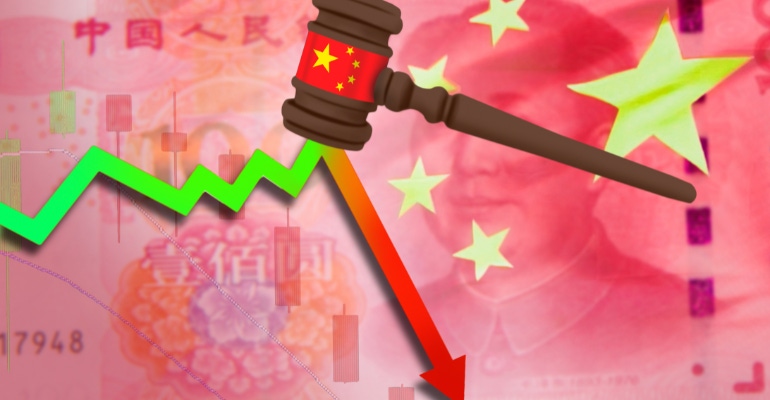China's VBP Regulation Impacts Medtronic Sales
China's volume-based procurement regulation has hurt Medtronic more so than other medtech firms.
February 22, 2023

In November 2018, China rolled out a volume-based procurement (VBP) policy to force pharmaceutical companies into lowering drug prices. But then, in 2019, China decided to implement a volume-based procurement policy for medical device companies.
The impact of this policy on the world's largest medical device company was evident in Medtronic's fiscal third quarter earnings. In particular, volume-based procurement tenders in China weighed on results for cardiac ablation solutions, neurovascular products (coils, specifically), and surgical stapling devices in the quarter.
"VBP has affected us more than many of our competitors, given the size and breadth of our business in China," CFO Karen Parkhill said, according to Seeking Alpha transcripts of Medtronic's earnings call.
In Medtronic's fiscal third quarter, the company's surgical interventions business declined as a result of stapling volume-based procurement tenders in China. But excluding China sales, the business grew 5% in the quarter. Similarly, the company's cardiac ablation solutions business grew 3% globally, while outside of China cardiac ablation solutions grew in the high single-digits. CEO Geoff Martha also said the neurovascular business grew 9% in the quarter but would have grown a couple points more if not for the China VBP.
Parkhill said the company expects volume-based procurement impacts to be halfway done by the end of this fiscal year, and the impacts should be 80% done by the end of fiscal year 2024. That will give Medtronic a new albeit lower revenue base to grow from going forward.
"We think that 80% of our portfolio, as we've taken a step back, could be impacted by VBP," CEO Geoff Martha said. "...And what we're doing here is taking out some of our selling and marketing costs in China to offset the lower prices because this business is now more contracted through this VBP. So, the government is living up to the volume commitments from those VBPs at these lower prices."
The discounts have gotten lower as they have gone on, he added.
"I think the Chinese government has realized that medtech is not exactly like pharma, and we have more selling expenses than maybe pharma does because I think they modeled a lot of this off of pharma ...," Martha said.
What is the purpose of volume-based procurement?
Essentially, the Chinese government adopted the volume-based procurement policy to lower the price of medical consumables by tendering the market volume of cities, provinces, or the country to manufacturers at the lowest price, according to a white paper on volume-based procurement written by Komarl Urde and published in October 2022 by Beroe, a North Carolina-based procurement specialist.
The paper also explains that the objective of volume-based procurement is to provide uniform pricing throughout the nation, increase technological advancements and innovation in China, focus on high-performing medical devices and affordable medical devices for patients, and lower healthcare costs for the government.
The Beroe paper notes that the top 10 high-value medical consumable companies have all undergone volume-based procurement tenders at the provencial level, with median publicly reported price cuts of roughly 70%.
"With the expected reduced revenue and margins among legacy products, medical device companies can focus on new state-of-the-art medical technologies," Urde writes.
According to the Beroe paper, medical device products were categorized into two groups based on hospital demand, manufacturer capacity, and raw materials in the national procurement of hip and knee implants.
"With the help of the VBP policy, there was a sharp decrease in the prices of medical devices," Urde writes. "The average selling price of a total knee replacement system was $5,000 before VBP. As the price of knee implants has dropped to much less than $800 on average, patients who have been hesitant to undergo surgical treatment due to economic constraints are now capable of undergoing the procedure."
The paper also explains how domestic competition in China has drastically increased in recent years. Previously, major Western medical device manufacturers dominated the Chinese drug-eluting stent market. Now, domestic Chinese stent makers account for more than 75% of the market share.
"Winning companies need not spend a lot of money on marketing or administrative costs if they win a bid through VBP, and a lower winning price reduces the overall profit," Urde writes.
But that's not to suggest that foriegn medical device companies can't succeed in China. According to the Beroe paper, medical devices made by Western companies are considered higher quality than domestically produced products and are favored by Chinese patients if the prices are reasonable.
How medical device companies can mitigate the impact of volume-based procurement in China
The Beroe paper offers several suggestions for medical device companies, a few of which are specific to Medtronic.
VBP has negatively impacted commoditized products, and Medtronic could focus on the pre-launch registration and post-launch commercialization of medical devices in its pipeline.
Medtronic can consider consolidating distributor layers, as VBP is expected to reduce margins. The distributor would focus more on logistics in such a scenario, according to the paper.
Procurement decisions are expected to shift from individual clinician decision-making to hospital administrators making portfolio decisions, the author writes, suggesting that Medtronic consider developing talent and commercial organizations to support portfolio- and account-level management strategies.
About the Author(s)
You May Also Like



.png?width=300&auto=webp&quality=80&disable=upscale)
